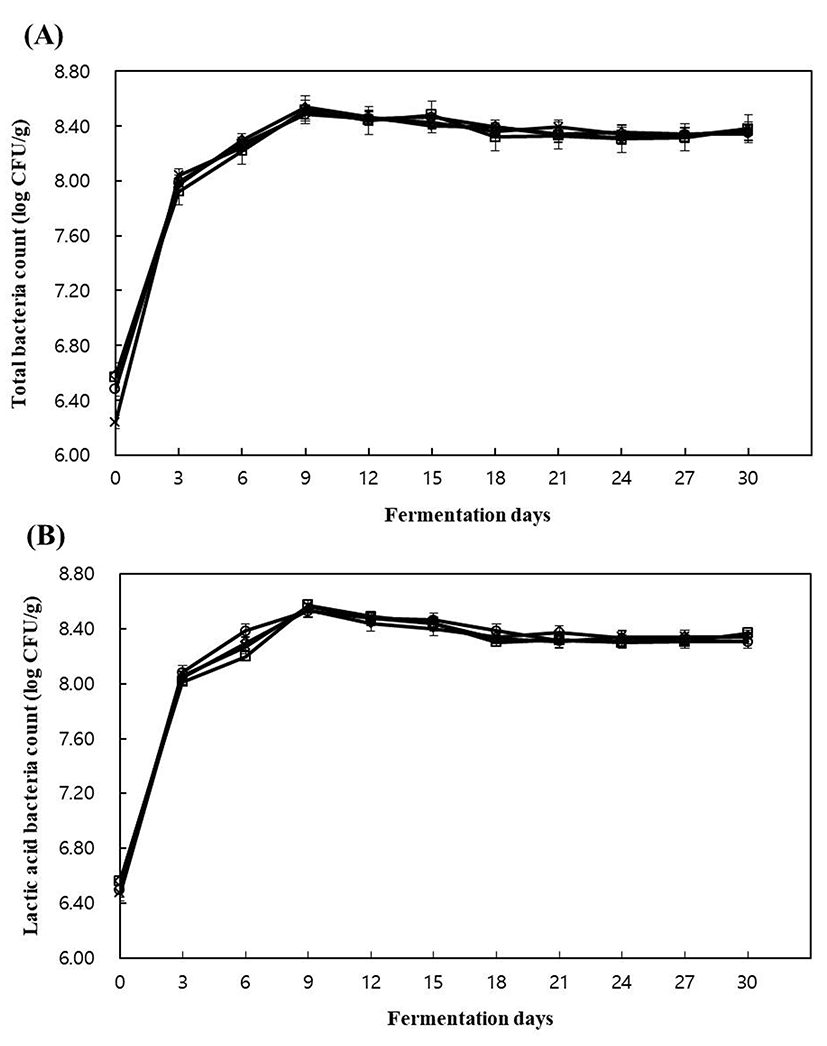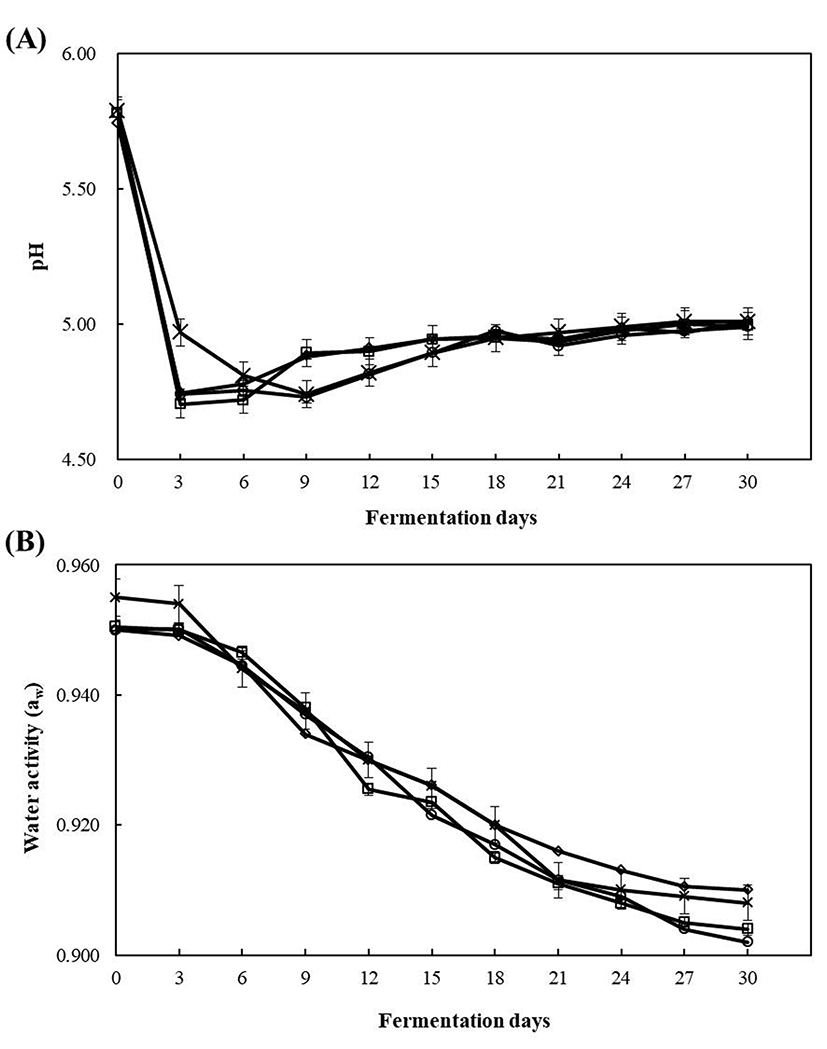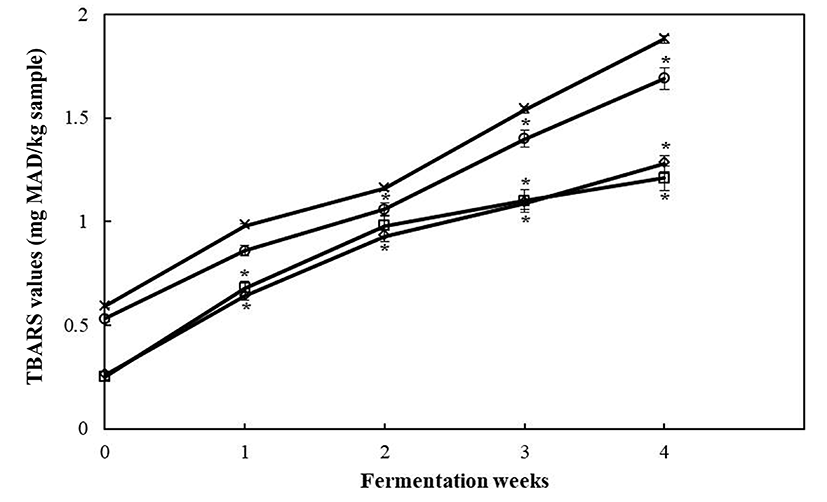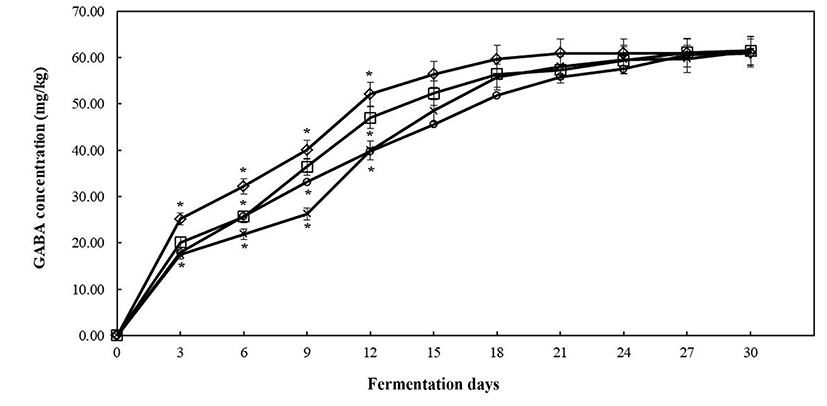Introduction
Fermented sausage is a mixture of comminuted fat, lean meat, salts, nitrate and/ or nitrite, sugar, and spices, which are stuffed into casings, subjected to fermentation with lactic acid bacteria (LAB) starter culture, and allowed to develop without heat treatment throughout the fermentation, followed by ripening and drying (Flores and Bermell, 1996; Luecke, 1997; Marta and Josep, 1997).
LAB play an important role in fermented foods, including dairy products, fermented sausage, and kimchi. LAB produce various compounds in addition to organic acids, including CO2, ethanol, mannitol, bacteriocins, γ-aminobutyric acid (GABA), conjugated linoleic acids, and oligosaccharides depending upon lactic acid bacteria species (Lee et al., 2015). In particular, GABA is a non-protein amino acid that is widely distributed among microorganisms, plants, and animals(Somkuti and Renye, 2012). Several GABA-producing LAB have also been isolated from kimchi, including Lactobacillus sakei and Lactobacillus brevis (Yu and Oh, 2011; Yu et al., 2017).
Kimchi is a traditional Korean fermented food that is prepared through a series of processes, including pretreatment of salted cabbage (or radish), blending with various spices and other ingredients, and fermentation. Kimchi is known as a nutritional food, since it contains high levels of dietary fibers, vitamins, carotene, and minerals (Cheigh et al., 1994). In addition, kimchi contains high levels of LAB (107-109 CFU/g), which also contribute various functional enzymes to the fermented product, such as cholesterol-lowering agents, and those involved in alcohol/acetaldehyde metabolism and the decarboxylation of glutamate, resulting in the release of the end products GABA and CO2 (Higuchi et al., 1997). We previously applied the strain L. brevis Y8 to fermented sausages and confirmed its GABA producing ability (Yu et al., 2017). In this current study, to further enhance the taste of meat products, the effects of the addition of kimchi to sausage fermented with strain Y8 were evaluated with respect to quality and taste components.
Previous studies have reported the characteristics of fermented sausages (Han et al., 2001; Lee and Kunz, 2005), and breakfast sausages (Lee et al., 2008) prepared with the addition of various types of freeze dried kimchi powders; however, these studies did not assess both the taste and functionality of the fermented sausages simultaneously. In the present study, we focused on the improvement of sensory characteristics and quality through the addition of Baechu-kimchi powder and application of the GABA-producing LAB strain to develop a new type of functional fermented sausage.
Materials and Methods
For the production of Baechu-kimchi powder, Baechukimchi (Korean cabbage kimchi), was purchased from retail outlets in Sejong City, Korea in November 2016. Hot air drying was performed in a hot air dryer (INBD-150E, Hansung, Korea) at 55±1℃. Next, Baechu-kimchi was pulverized with a blender (BL311E, Tefal, France) and the powder was stored in a deep freezer (-72℃) until further use.
L. brevis Y8 isolated from kimchi, which has been previously confirmed to have high GABA-producing ability, was prepared as a starter culture.
Fermented sausage was manufactured according to the following formulation: 200 g/kg lean beef, 600 g/kg lean pork, 200 g/kg pork back fat. For each kilogram of meat product, 30 g/kg sodium chloride, 5 g/kg glucose, and 0.07 g/kg NaNO2 were added along with bacterial cultures, Baechu-kimchi powder, and spices. The commercial product starter cultures mixture (BacterfermTM C-P77S, Chr. Hansen, Denmark) and GABA-producing LAB L. brevis Y8 were added at a 1:1 ratio. The control sample was produced without addition of the Baechu-kimchi powder. The Baechu-kimchi powder was incorporated into the sausages at levels of 0.5% (K0.5), 1.0% (K1.0), or 2.0% (K2.0). The mixture was stuffed into 40 mm diameter fibrous casings and fermented for 1 d at 23°C and relative humidity (RH) of 95% followed by a gradual reduction of temperature (from 22℃ to 19℃) and RH (from RH 94% to 89%) during the next 7 d. After 7 d of fermentation, the sausages were ripened for 30 d at 18℃ (RH 75%).
Microbiological analyses were performed immediately after the manufacturing processes and during the fermentation period as described by Yu et al. (2017). The samples were serially diluted in a sterile saline solution; plated onto de Man, Rogosa and Sharpe (MRS) agar (Difco, France); supplemented with 0.0006% bromocresol purple (BCP, Sigma, USA); and incubated for 48 h. Then, the serially diluted sterile saline solution was spread on plate count agar (Difco, France) at 37℃ for 48 h. The number of microorganisms was expressed as the log10 of colony forming units (CFU) per g. For physicochemical analyses, ten grams of the samples were homogenized in a stomacher with 90 mL of distilled water, and the pH of the homogenate was measured using a pH meter (Orion 3 star pH Benchtop; Thermo Scientific, USA). Water activity was measured using an electric hygrometer (Thermoconstanter, Switzerland).
Colorimeter (Chroma meter CR-300, Minolta, Japan; illuminate C), calibrated with white standard plate, L* = 97.18, a* = -0.08, b* = +1.87. CIE L* (lightness), CIE a* (redness) and CIE b* (yellowness) of samples were taken in triplicate for each sample.
The textural properties for each sausage was measured by a spherical probe (0.25 mm diameter), set attached to a Texture Analyzer (TA-XT2i, Stable Micro System Ltd., UK). Texture analysis conditions were as follows: stroke, 2 kg; test speed, 2.0 mm/s; distance, 8 mm. Data were collected and analyzed from the hardness (N), springiness, cohesiveness, gumminess (N), and chewiness (N) values.
TBARS was homogenized by adding 20 mL of 20% trichloroacetic acid to 20 g of the sample according to the method of Witte et al. (1970). Five milliliters of the filtrate was reacted with 2-thiobarbituric acid solution, and the absorbance was measured at 530 nm (Bio-TEK Instrument Inc., USA).
Analysis of GABA in fermented sausages by HPLC was carried out according to the procedure by Yu et al. (2017). The derivatives were then separated using an AccQ • TagTM column (3.9 × 150 mm, 4 µm particle size, Nova-Pak C18; Waters) at 35℃. The mobile phase was composed of AccQ • Tag eluent A (Waters) and 60% aqueous acetonitrile (ACN, JTBaker, Holland). The elution flow rate was 1.0 mL/min. The GABA content was calculated using a commercial GABA standard based on a standard curve.
BA contents in fermented sausages were analyzed according to the procedure developed by Ben-Gigirey et al. (1999).
Results and Discussion
In all experimental groups, the number of LAB increased sharply from 6.5-6.6 Log CFU/g to 8.0-8.1 Log CFU/g within 3 d from the start of fermentation (Fig. 1B). This rapid growth of LAB at the initial stage of fermentation decreased the pH of the fermented sausages. Although the LAB count was directly related to the pH, the addition of Baechu-kimchi powder at different amounts did not influence the LAB count when compared with that of the control (without Baechu-kimchi powder), with a final LAB count of 8.3 Log CFU/g detected in all groups. The total bacteria count in all experimental groups showed a similar growth pattern to that of the LAB count during fermentation (Fig. 1A), indicating that the LAB dominated in the sausage fermentation process.

Changes in the pH values of the fermented sausages during ripening are shown in Fig. 2A. There was a rapid decrease in the pH from the initial value (5.74-5.79) to 4.97 and 4.50 at 3 d of ripening, for the control group and Baechu-Kimchi powder-added groups, respectively. The decrease pH of fermented sausages was probably caused by the lactic acid from the LAB (Bover-Cid et al., 2001). Park and Lee (2012) showed the same trend in pH resulting from the addition of kimchi and freeze-dried kimchi powder to fermented sausage. In general, following this initial decrease, the pH of sausages tends to increase during ripening due to the production of proteolytic enzymes, ammonia, and amines formed during the amino acid catabolism by LAB (Benito et al., 2007; Dierick et al., 1974; Rice and Koehler, 1976). Indeed, the pH increased throughout the ripening phase in all samples, reaching final values in the range of 4.99 to 5.21. Changes in the water activity (aw) in all sausages are shown in Fig. 2B. The initial aw of all samples was in the range of 0.955-0.950. At the end of the ripening period, the aw levels of the control and kimchi treatment group sausages were 0.902 and 0.910, respectively, with no statistically significant difference detected between the groups. The addition of Baechu-kimchi powder had no impacts on the aw of fermented sausages.

At the end of the ripening period (day 30), the control sausages were lighter in color than those fermented with the addition of Baechu-kimchi powder (Table 1). Along with this decrease in lightness, the redness (a*) and yellowness (b*) values increased with an increasing level of kimchi powder, and the highest values were observed for the sausage containing Baechu-kimchi powder 2.0%. Similar results were reported in a previous study (Lee et al., 2008), color parameters values of breakfast sausage that were affected by the kimchi powder content. Taken together, it seems likely that the redness of original Baechu-kimchi affects the color of the fermented sausage products.
1)Control, fermented sausage containing strain GABA-producing LAB isolate Y8; Y8+K0.5, fermented sausage containing Baechu-kimchi powder 0.5% and isolate Y8; Y8+K1.0, fermented sausage containing Baechu-kimchi powder 1.0% and isolate Y8; Y8+K2.0, fermented sausage containing Baechu-kimchi powder 2.0% and isolate Y8.
2)Results are expressed as the means±standard deviation.
a-dmeans with different letters within a row are significantly different at p<0.05 as determined by Duncan’s multiple-range test.
The textural properties of fermented sausages manufactured with different levels of Baechu-kimchi powder are shown in Table 2. The addition of kimchi powder to the sausages caused significant increases in the hardness and chewiness. Similar findings have been reported for breakfast sausage, chorizo, and fermented sausage following the addition of kimchi powder, tiger nut fiber, and fruit fiber; however, the texture was not affected by cereal fiber (Lee et al., 2008; Sánchez-Zapata et al., 2013; Steenblock et al., 2001). There were no significant differences in the cohesiveness or gumminess of the kimchi powder-treated sausages, from controls, although the springiness values increased with kimchi powder addition. Since the springiness value is related to the elastic properties of a meat sample, an increase in the springiness value indicates improvement in the elasticity of the sausage due to kimchi powder. Overall, these results indicate that the level of Baechu-kimchi powder added has a positive influence on the textural characteristics of the fermented sausage.
1)Control, fermented sausage containing commercial starter cultures (Staphylococcus carnosus and L. pentosus); Y8, fermented sausage containing strain GABA-producing LAB isolate Y8; Y8+K0.5, fermented sausage containing Baechu-kimchi powder 0.5% and isolate Y8; Y8+K1.0, fermented sausage containing Baechu-kimchi powder 1.0% and isolate Y8; Y8+K2.0, fermented sausage containing Baechu-kimchi powder 2.0% and isolate Y8.
2)Results are expressed as the means±standard deviation.
a-dmeans with different letters within a row are significantly different at p<0.05 as determined by Duncan’s multiple-range test.
Lipid oxidation levels in the fermented sausages were evaluated according to TBARS values, which may affect the color, aroma, flavor, texture and even the nutritive value of foods (Fernández-López et al., 1997). The TBARS values of fermented sausages containing Baechu-kimchi powder were considerably lower than those of the control at the end of the ripening period (Fig. 4), suggesting that kimchi powder influences the lipid oxidation process. These results are in line with previous studies (Hwang and Song, 2000; Cheigh et al., 1994), and it has been suggested that the antioxidative phenolic compounds of kimchi may contribute to the strong antioxidative activity observed (Cheigh et al., 1994; Woo and Jeong, 2006).

The 100 mg/kg of histamine in food has been suggested as an upper limit for human consumption, and 100-800 mg/kg of tyramine and 30 mg/kg of β-phenylethylamine have been reported to be toxic doses in food (Brink et al., 1990). All of the sausages produced in the present study showed low amine levels, including 1.52-5.50 mg/kg of histamine, 16.97-21.78 mg/kg of tyramine, and 1.73-11.26 mg/kg of β-phenylethylamine at the end of the fermentation period (Table 3). Of note, the amounts detected from all amines were below the levels deemed to be hazardous for human health.
1)Control, fermented sausage containing strain GABA-producing LAB isolate Y8; Y8+K0.5, fermented sausage containing Baechu-kimchi powder 0.5% and isolate Y8; Y8+K1.0, fermented sausage containing Baechu-kimchi powder 1.0% and isolate Y8; Y8+K2.0, fermented sausage containing Baechu-kimchi powder 2.0% and isolate Y8.
2)Trp: tryptamine, Phe: ß-phenylethylamine, Put: putrescine, Cad: cadaverine, His: histamine, Tyr: tyramine, Spd: spermidine, Spm: spermine
3)ND: Not detected
4)Results are expressed as the means±standard deviation.
a-cmeans with different letters within a row are significantly different at p<0.05 as determined by Duncan’s multiple-range test.
In our previous study (Yu et al., 2017), we isolated L. brevis Y8 from kimchi samples, which was shown to produce high amounts of GABA. We also found that strain Y8 produced, 61.30 mg/kg GABA in fermented sausage, indicating the suitability of isolated L. brevis Y8 as GABA-producing bacteria in fermented sausage. As shown in Fig. 3, the GABA concentrations increased on the third day of fermentation ranging from, 17.42 to 25.14 mg/kg. This suggests a potential relationship between the GABA content and pH in fermented sausage, since the pH also decreased on the third day of fermentation as mentioned above. Indeed, Cho et al. (2011) reported a highly significant correlation between pH decline and GABA contents in mukeunjee kimchi. Similarly, Yang et al. (2008) and Barla et al. (2016) reported that low pH had a positive effect on the GABA-producing ability of LAB. The GABA content continued to increase during fermentation from the third day, reaching a level of 60.95-61.47 mg/kg at the end of fermentation. A previous study showed that oral administration of 10 mg GABA per day for 12 wk could effectively control blood pressure in hypertensive patients (Inoue et al., 2003). Moreover, Okada et al. (2000) reported that oral administration of 26.4 mg GABA produced in rice germ was effective in the treatment of neurological disorders. Based on this context, our results suggest that the amount of GABA produced in sausage products fermented with strain Y8 may be sufficient to provide functionality to human health.
Finally, a sensory evaluation was performed to assess the specific parameters of color, taste, odor, chewiness, and juiciness, as well as the overall acceptability of the fermented sausages. As shown in Table 4, the taste, flavor, and juiciness scores all increased with increasing levels of kimchi powder added. Numerous previous studies have indicated that the flavor and taste of meat products are influenced by various additives such as cheese powder (Xiang et al., 2017), lemon albedo (Aleson-Carbonell et al., 2003), fruit purees (Leheska et al., 2006), and fruit fibers (García et al., 2007). In terms of off-flavor properties, the sausages inoculated with GABA-producing LAB (L. brevis Y8) scored higher than those with the addition of Baechu-kimchi powder. L. brevis has commonly been used as a starter culture for inhibits the growth of gramnegative microorganisms, the strain helps to prolong the shelf-life by several days (Fetlinski et al., 1979). However, the high levels of acetic acid and 3-methylbutanal produced by the hetero-fermentative bacteria results in significant off-flavors (Buckenhueskes, 1993; Larrouture et al., 2000; Luecke and Hechelmann, 1986). Thus, the addition of kimchi powder could reduce the unpleasant odors occurred in fermented sausages as well as improve the preference score with a familiar taste and/or flavor. As a result, the fermented sausage with 2% Baechu-kimchi powder showed not only the lowest score with respect to unpleasant odors but also had the highest scores related to flavor, taste, and overall acceptability.
1)Control, fermented sausage containing strain GABA-producing LAB isolate Y8; Y8+K0.5, fermented sausage containing Baechu-kimchi powder 0.5% and isolate Y8; Y8+K1.0, fermented sausage containing Baechu-kimchi powder 1.0% and isolate Y8; Y8+K2.0, fermented sausage containing Baechu-kimchi powder 2.0% and isolate Y8. 2)Results are expressed as the means±standard deviation.
a-cmeans with different letters within a row are significantly different at p<0.05 as determined by Duncan’s multiple-range test.
Conclusions
In this current study, the physicochemical, microbial, and sensory properties of fermented sausage prepared with GABA-producing LAB strain Y8 and Baecu-kimchi powder were evaluated. The results demonstrated that the LAB content was similar in all samples of fermented sausage, reaching a maximum count of 8.53-8.57 Log CFU/g after 9 d of ripening. The addition of Baechu-kimchi powder to the fermented sausage increased the hardness, chewiness, and red and yellow values, while decreasing the lightness value. Moreover, the addition of Baechu-kimchi powder to the sausages had an antioxidant effect against lipid oxidation and decreased off-flavors related to the growth of undesirable bacteria. The amount of GABA in all fermented sausages was 60.95-61.47 mg/kg.
Overall, these results suggest that Baechu-kimchi powder and GABA-producing LAB could be effective ingredients for a functional fermented sausage with GABA, without impacts on quality characteristics. Further, these ingredients would be used to develop new types of healthy and functional fermented meat products.














